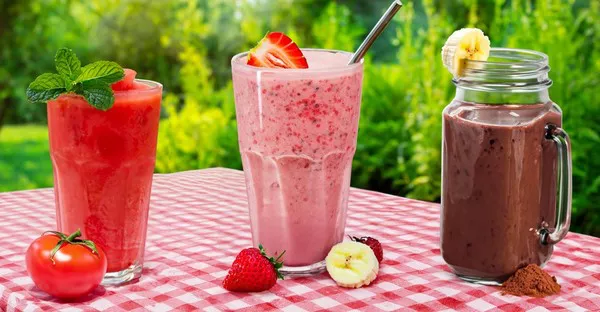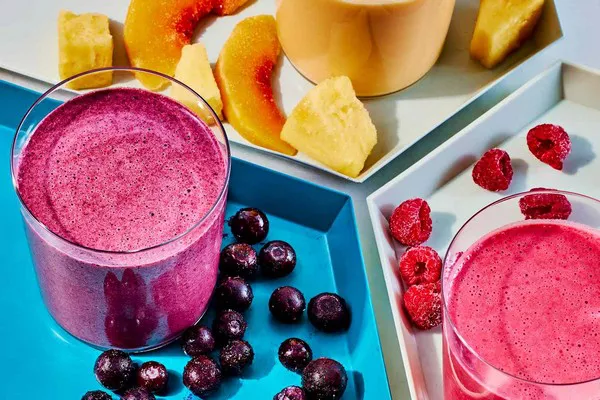Fruit smoothies have become a popular choice for a quick, nutritious meal or snack. Packed with vitamins, minerals, fiber, and antioxidants, they offer a convenient way to boost your intake of fruits and vegetables. Whether you’re looking to start your day with a refreshing drink or replenish nutrients after a workout, a well-balanced fruit smoothie can be a delicious and satisfying option. In this article, we’ll explore the essentials of making a healthy fruit smoothie, from selecting the right ingredients to blending techniques that preserve nutritional value.
Benefits of Fruit Smoothies
Before delving into the specifics of making a healthy fruit smoothie, let’s highlight some of the benefits:
1. Nutrient-Rich: Fruits and vegetables used in smoothies are rich in essential nutrients like vitamins A, C, and K, as well as potassium, folate, and fiber.
2. Hydration: Smoothies are an excellent way to stay hydrated, especially when made with water, coconut water, or milk alternatives like almond milk.
3. Digestive Health: The fiber content in fruits aids digestion and promotes gut health.
4. Quick and Convenient: They can be prepared quickly and consumed on the go, making them ideal for busy lifestyles.
5. Versatility: Smoothies can be customized to suit individual taste preferences and dietary needs.
Essential Ingredients for a Healthy Fruit Smoothie
1. Base Liquid
Choosing the right liquid base sets the foundation for your smoothie. Options include:
- Water: Simple and calorie-free, water can be used to keep the smoothie light.
- Coconut Water: Adds electrolytes and a hint of sweetness.
- Almond Milk, Soy Milk, or Oat Milk: Dairy-free alternatives that add creaminess and nutrients.
- Greek Yogurt: Provides protein and a creamy texture.
2. Fruits and Vegetables
Select a variety of fresh or frozen fruits and vegetables. Aim for a mix of colors to ensure a diverse range of nutrients:
- Berries: Blueberries, strawberries, raspberries are rich in antioxidants.
- Bananas: Add creaminess and natural sweetness.
- Leafy Greens: Spinach, kale, or Swiss chard boost the nutrient content without overpowering the flavor.
- Avocado: Adds creaminess and healthy fats.
- Citrus Fruits: Oranges, lemons, or limes for a refreshing tang.
3. Protein and Healthy Fats (Optional)
Enhance the nutritional profile and satiety of your smoothie by adding:
- Protein Powder: Whey, plant-based, or collagen protein powders can boost protein content.
- Nut Butters: Peanut butter, almond butter, or cashew butter add richness and healthy fats.
- Chia Seeds or Flaxseeds: Provide omega-3 fatty acids and fiber.
- Greek Yogurt: High in protein and probiotics.
4. Sweeteners and Flavor Enhancers (Optional)
Limit added sugars by using natural sweeteners sparingly:
- Honey or Maple Syrup: Adds sweetness with added nutrients.
- Dates: Blend well and offer natural sweetness and fiber.
- Vanilla Extract: Enhances flavor without additional calories.
Steps to Make a Healthy Fruit Smoothie
1. Prepare Your Ingredients
- Wash and Chop: Rinse fresh fruits and vegetables thoroughly. Peel and chop larger fruits like apples or mangoes.
- Measure Ingredients: Use measuring cups or a kitchen scale to ensure proper portions.
2. Layer Ingredients in Blender
- Liquid First: Add your chosen liquid base to the blender. This helps blades move easily and ensures even blending.
- Fruits and Vegetables: Add fruits, vegetables, and any optional additions like protein powder or seeds.
- Ice (Optional): For a colder, thicker smoothie, add ice cubes.
3. Blend Until Smooth
- Start Slowly: Begin blending on low speed to break down larger pieces.
- Increase Speed: Gradually increase speed to high for a smooth consistency.
- Blend Thoroughly: Blend for 30-60 seconds or until ingredients are fully combined and smooth.
4. Adjust Consistency and Taste
- Check Thickness: Add more liquid if too thick or more fruits/ice if too thin.
- Adjust Sweetness: Taste and add sweeteners or additional fruits if needed.
5. Serve and Enjoy
- Pour Smoothie: Transfer to a glass or bowl.
- Garnish (Optional): Top with fresh fruit slices, seeds, or a sprinkle of granola for added texture.
- Enjoy Immediately: Smoothies are best consumed fresh to retain nutrients and flavors.
SEE ALSO: How Can I Make a Strawberry Banana Smoothie
Tips for Making the Best Healthy Fruit Smoothie
1. Use Frozen Fruits
- Preserve Freshness: Frozen fruits are convenient and help maintain freshness and nutrient content.
- Thicker Texture: Create a thicker texture without diluting flavors with excess ice.
2. Balance Sweetness and Nutrition
- Limit Added Sugars: Opt for natural sweeteners sparingly to maintain a healthy balance.
3. Experiment with Flavors
- Mix and Match: Combine different fruits, vegetables, and add-ins to discover new flavors and nutrient combinations.
- Seasonal Varieties: Use seasonal produce for optimal freshness and flavor.
4. Preparing Ahead
- Batch Preparation: Prepare smoothie packs by portioning ingredients in advance for quick blending.
- Freeze Leftovers: Freeze leftover smoothies in popsicle molds for a refreshing treat.
Conclusion
Creating a healthy fruit smoothie involves selecting nutritious ingredients, balancing flavors, and blending to perfection. Whether you prefer a simple blend of berries and yogurt or a green smoothie packed with leafy greens and avocado, the key is to prioritize freshness and variety. By following the steps outlined in this article and experimenting with different combinations, you can enjoy delicious and nutrient-packed smoothies that support your overall health and well-being. Incorporate smoothies into your daily routine for a convenient way to nourish your body with essential vitamins, minerals, and antioxidants. Cheers to health and happiness with every sip!
Related Topics:
























